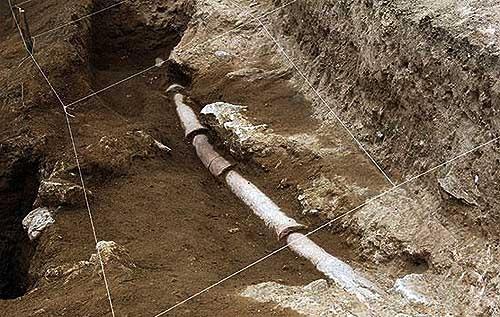Iran has often been referred to as the land of roses and nightingales, and the reason for this is the gardens located in Shiraz and Isfahan, two ancient cities of Iran, which have long inspired romantic poets and dreamers. However, this land of roses and nightingales is not green and lush everywhere; much of the Iranian plateau is covered by rugged, impassable mountains and dry deserts. For this reason, from ancient times, the management of water resources and finding ways to extract water from underground sources have been a priority and a source of inspiration for innovative engineers (derived from the book 5000 Years of Iranian Engineering).
The Invention of the Qanat
If innovative Iranian engineers had not created the underground water delivery system known as the qanat, many of the towns and villages in Iran located near arid deserts would not exist today.
A qanat, or kariz, is essentially a horizontal underground canal that can carry water from a watershed area to far distances that are dry and waterless. The length of these canals can sometimes reach tens of kilometers.
Today, from China to North Africa, this Iranian technology is used for irrigation, and thanks to it, nearly 1.5 million hectares of land worldwide are cultivated.
But when and where was this interesting and complex technology first discovered and implemented?
Dr. Xavier De Planhol stated in the Encyclopaedia Iranica: “The digging of underground water channels began in the Iranian plateau for agriculture dependent on irrigation, and its spread beyond Iran’s borders was directly linked to Iran’s culture and political power during the Achaemenid era (538 to 330 B.C.).”
Polybius, a Greek historian who lived around 200 B.C., provides the earliest and clearest reference to the qanat. Polybius clearly confirms the existence of underground water canals on the southern slopes of the Alborz mountains near the city of Hekatompylos (modern-day Damghan).
It is estimated that nearly 50,000 qanats exist in Iran, and if we assume an average length of seven kilometers for each qanat, the total length of Iran’s qanats would be 350,000 kilometers—equivalent to the distance from the Earth to the Moon.
Gonabad Qasabeh Qanat
One of the oldest and most famous qanats in Iran is the Gonabad Qasabeh Qanat in Khorasan. This qanat has supplied drinking and agricultural water to the region for over two thousand years. The fame of this qanat has attracted many historians and travelers to Khorasan.
Nasir Khusraw, the renowned Iranian poet and traveler (394-481 A.H.), provides a complete description of this qanat in his travelogue, estimating its depth at 700 gaz (about 300 meters) and its length at four farsakhs (about 24 kilometers).
Bridge-Dams
Humanity fully mastered its water resources when it learned to block the rushing waters of rivers and store them by building dams. Once dam construction techniques reached a high level, some dams were built to serve both as a dam and as a bridge for crossing the river.
There are two types of dams: gravity dams and arch dams. The first type, as its name suggests, must be extremely heavy to withstand the pressure of the water. One of the gravity dams that has stood for nearly a thousand years is Band-e Amir. Band-e Amir was constructed during the Buyid dynasty on the Kor River in Fars under the orders of Adud al-Dawla. The Buyids (322-447 A.H.) nominally accepted the caliphate in Baghdad but held real power in Iran and Iraq.
Band-e Amir is 80 meters long and about 10 meters high. This multi-purpose dam also served as a bridge, providing agricultural and drinking water to the region, as well as powering many water mills.
One of the most elegant and functional bridge-dams in Iran is Khaju Bridge, built during the Safavid era in Isfahan. This bridge was constructed on a foundation of stone and lime, which also acts as a dam. The bridge’s sophisticated structure was designed with sluice gates to control the flow of water. As the Zayandeh River passes through the twenty-four canals of the bridge, its flow becomes balanced and calm. In the middle of the bridge, there is an octagonal pavilion where Safavid kings and their courtiers would sit and watch aquatic sports and shows.
Arch Dam
The Kabir Dam on the road between Qom and Kashan is one of the oldest arch dams in Iran that still stands. The arch shape is the strongest form for resisting the pressure of water.
The Kabir Dam, built about 700 years ago, originally stood 26 meters high and 55 meters long. Today, it has been reinforced with concrete walls to withstand the pressure of the water collected in its reservoir.
Another of Iran’s arch dams is the Kharit Dam in Tabas. This dam, built after the Kabir Dam, stands 60 meters tall.
Ancient Water Purification System
Here, it is important to mention an extraordinary and significant ancient water engineering achievement. Today, the abundance of clean and clear water makes us forget the meticulous processes involved in purifying drinking water. Our ancestors, in ancient times, took essential and significant measures to obtain clean and safe water. One such measure was carried out by the Elamites 3200 years ago in Khuzestan.
Next to the city of Untash, now known as Chogha Zanbil, the ruins of facilities related to an ancient water purification system still remain, discovered by the French archaeologist Roman Ghirshman in 1962. These brick-built facilities include a large reservoir (the main source) and several basins. The reservoir is 10.70 meters long, 7.25 meters wide, and 4.35 meters deep, with an estimated capacity of about 350 cubic meters.
Darius’ Canal
Another astonishing engineering marvel of the ancient world was the construction of a canal connecting the Red Sea to the Mediterranean Sea. This ancient prototype of the Suez Canal, known as Darius’ Canal, began at the Gulf of Suez in the Red Sea, continued northwest to the Nile Delta, and finally reached the Mediterranean Sea through one of the Nile’s main branches.
This canal, built around 500 B.C. by order of Darius the Great, was 50 meters wide and 145 kilometers long, linking two of the world’s great seas. It is undoubtedly one of the most brilliant engineering achievements of the ancient world.
Five granite inscriptions were placed along the banks of this canal to honor this glorious achievement.

